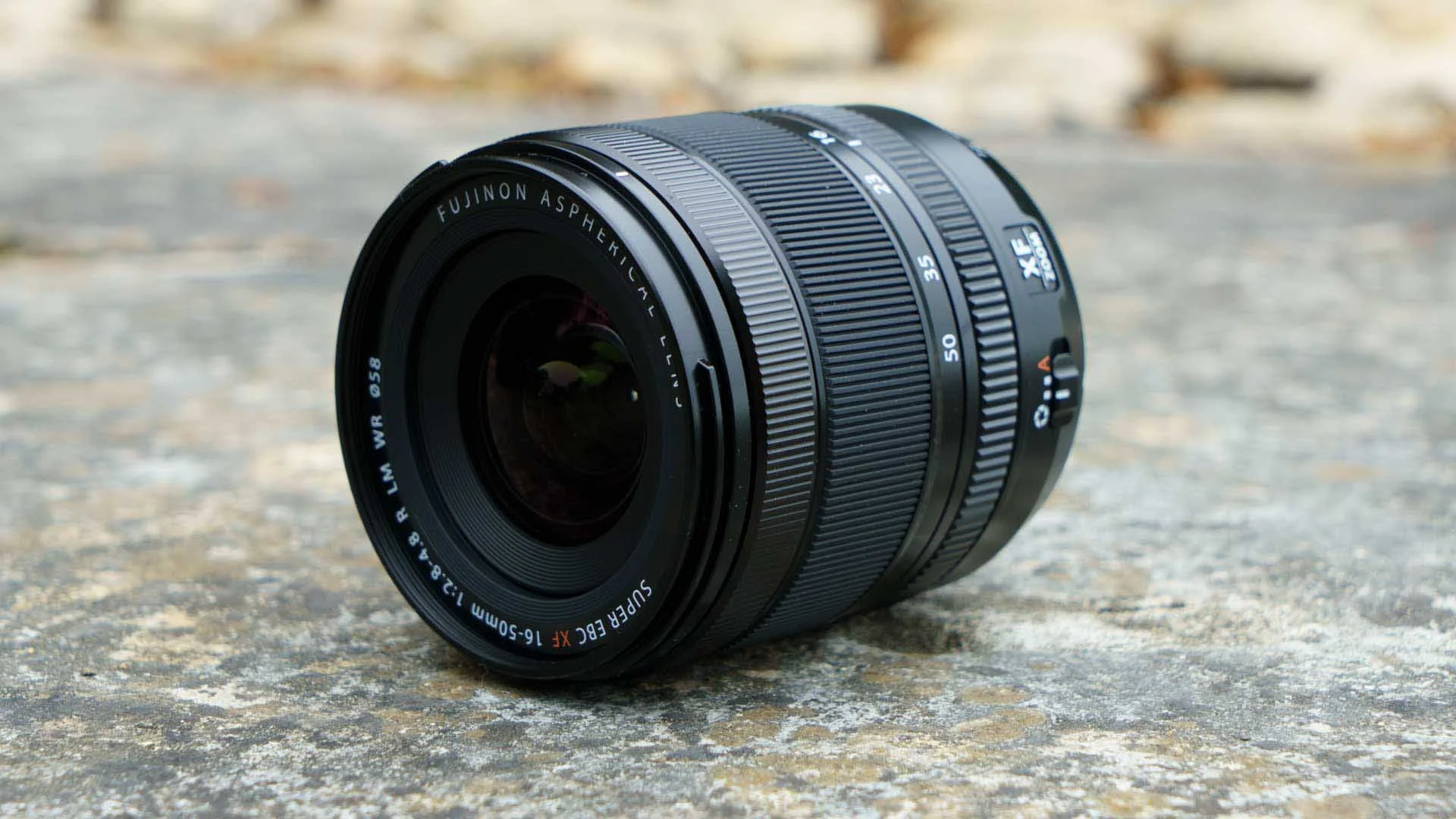Fujifilm Fujinon XF 16-50mm F2.8-4.8 R LM WR Hands-on Review
Summary Verdict
The new Fujifilm XF 16-50mm F2.8-4.8 R LM WR looks and feels good. It facilitates fast autofocusing and aberrations appear to be kept in control well, although this needs to be verified with further testing.
Score: TBC
For
Small and light
Weather-sealed
Designed to match Fujifilm’s 40MP sensors
Against
The aperture ring doesn’t have setting marks
What is the Fujifilm Fujinon XF 16-50mm F2.8-4.8 R LM WR?
The Fujifilm Fujinon XF 16-50mm F2.8-4.8 R LM WR has the Fujifilm X mount and is designed to be used on the company’s X-series cameras such as the Fujifilm X-T5 and the new Fujiilm X-T50. It replaces the current Fujifilm XF 18-55mm F2.8-4 R LM OIS. It will be sold separately and in kits with various X-Series cameras, including the new Fujifilm X-T50 and the existing Fujifilm X-T5.
Fujifilm XF 16-50mm F2.8-4.8 R LM WR Price and Availability
The Fujifilm XF 16-50mm F2.8-4.8 R LM WR price is £699 / $699 / €799, and it will go on sale from 28th May 2024. It will also be sold with the Fujifilm X-T50, X-T5 and X-S20 in kits as follows:
With X-T50: £1649 / $1799 / €1899
With X-T5: £2049 / $2099 / 2399
With X-S20: £1599 / $1699 / €1599
These kits will be available from 28th May 2024.
Read our Fujifilm X-T50 Review
Fujifilm XF 16-50mm F2.8-4.8 R LM WR Specifications
Lens type: Standard zoom
Announced: 16th May 2024
Mount: Fujifilm X
Construction: 11 elements in 9 groups with 3 ED and 3 aspherical elements
Number of aperture blades: 9
Zoom mechanism: Internal
Focusing mechanism: Internal linear motor
Minimum focus distance: 24cm, giving 0.3x magnification
Weather sealed: at 13 points
Dimensions (WxHxD): 123.8 x 84 x4 8.8 mm
Weight: 240g
The Fujifilm XF 16-50mm F2.8-4.8 R LM WR weighs 240g, that’s 70g less than the XF 18-55mm F2.8-4 R LM OIS it replaces.
Features
As the Fujifilm XF 16-50mm F2.8-4.8 R LM WR is used on APS-C format cameras, it has an effective focal length of 24-76mm. This makes it an attractive option for every day, general photography.
The lens is constructed from 11 elements arranged in 9 groups with 3 ED (extra low dispersion) and 3 aspherical elements to keep size and weight down while maintaining image quality across the frame at all focal lengths.
Internal zoom and focusing mechanisms mean that the lens doesn’t change length when zooming or focusing, and there’s a 9-blade aperture.
Fujifilm has employed a linear focusing motor to deliver smooth, silent focusing and the closest focusing distance is 24cm from the sensor, at which the magnification is 0.3x.
Although the Fujifilm XF 16-50mm F2.8-4.8 R LM WR only weighs 240g, it is weather sealed.
The Fujifilm XF 16-50mm F2.8-4.8 R LM WR makes a nice, versatile kit with the Fujifilm X-T50 announced at the same time.
Build and Handling
The Fujifilm XF 16-50mm F2.8-4.8 R LM WR is a small, light lens that looks at home on a small camera like the Fujifilm X-T50 announced at the same time. It makes for a nice balanced set up and I would be happy to carry the camera and lens around without a strap for an hour or so.
When I wasn’t using the XF 16-50mm F2.8-4.8 R LM WR on the X-T50, I slipped the lens in my jacket pocket, ready to snap onto the camera when I needed it.
While the XF 16-50mm F2.8-4.8 R LM WR has an aperture ring, it doesn’t have marked settings, you simply rotate the ring one way or the other to adjust the value and there are no physical end points. It also has a switch that activates or deactivates the aperture ring. When the ring is deactivated, the aperture is either set automatically or via a command dial on the camera.
Zooming from the 16mm point to 50mm takes less than a quarter turn, and the action is smooth with just the right amount of effort required. The narrow facing ring also feels well made and has a pleasant feel when it rotated. Like the aperture ring, the adjustment is made electronically so there’s no fixed end points for manual focus adjustment.
It’s good to see a metal mount on the Fujifilm XF 16-50mm F2.8-4.8 R LM WR.
Performance
I used the Fujifilm XF 16-50mm F2.8-4.8 R LM WR on the X-T50 for a few hours ahead of their announcement on 16th May 2024 and they make a nice pairing. It was quickly apparent that the lens supports the T subject detection as the camera put boxes around various animals when they appeared in the frame with the system set to detect animals. When the animals were close enough for their eyes to be clearly visible, small boxes appeared around their eyes. The focusing system is also swift and silent.
I need to shoot a lot more images with the XF 16-50mm F2.8-4.8 R LM WR before this review is finalised, but on the basis of what I have seen so far it seems to keep flare under control and neither vignetting and chromatic aberration are a problem.
Fujifilm XF 16-50mm F2.8-4.8 R LM WR Sample Images
Image Credit: Angela Nicholson This image was captured using the X F16-50mm F2.8-4.8 R LM WR kit lens on the Fujifilm X-T50. Shooting at the 50mm point and at an aperture setting of f/4.8 has separated the flower from the background nicely.
Image Credit: Angela Nicholson There’s a pleasing level of detail captured in images using the Fujifilm XF 16-50mm F2.8-4.8 R LM WR.
Image Credit: Angela Nicholson The subject detection system detected the gorilla’s eyes and got the focusing spot-on here.
Image Credit: Angela Nicholson The closest focusing distance of the XF 16-50mm F2.8-4.8 R LM WR is 24cm. That’s close enough for framing-filing shots of small subjects.
Image Credit: Angela Nicholson There’s no sign of coloured fringing in this scene.
Image Credit: Angela Nicholson Vignetting (corner darkening) doesn’t appear to be a problem with the Fujifilm XF 16-50mm F2.8-4.8 R LM WR.
Early Verdict
So far, the Fujifilm XF 16-50mm F2.8-4.8 R LM WR seems like a good replacement for the existing Fujinon XF 18-55mm F2.8-4 R LM OIS. Paired with a 40MP sensor, it's capable of capturing a high level of detail and aberrations appear to be controlled well, although I will be investigating this further with more testing soon.










